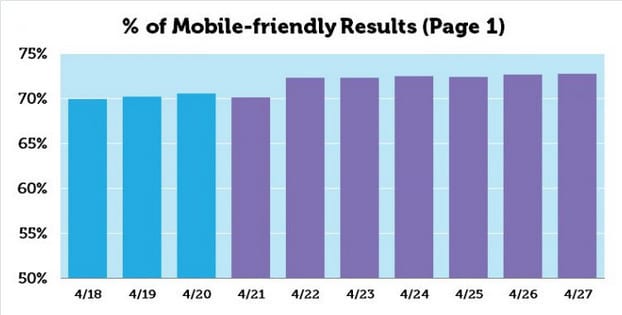Web Development, Website Design & UX
4 Minutes
The Importance Of Mobile Friendly Websites
They’re calling it MobileGeddon, and although the nickname seems a little dramatic, it’s been a huge wake up call for any developers and website owners who haven’t been proactive enough to update their sites to be mobile responsive. Google rolled out changes on April 21st, 2015 to it’s algorithms that expanded its use of ‘mobile-friendliness’ as a ranking factor. This means that a lot of websites out there could be hit pretty hard in the mobile search results.
According to the marketing company Merkle/RKG, 29% of the top 500 retail companies and almost 50% of the Fortune 500 companies do not have mobile friendly websites. So this update has the potential to cause a big upset in the world of e-commerce.
A Mobile Friendly Website Has Always Mattered
In general, since the dawn of mobile devices and the increasing usability of them to browse the internet, it has been important for many years to update your site to be mobile friendly. According to the advertisement network InMobi, a whopping 60% of internet traffic comes from mobile devices now, and other research groups have estimated that the amount of shoppers using mobile devices rose to 35% in 2014. So if you don’t have a mobile friendly website, that’s a lot of users that cannot view your site, and a lot of potential clients or customers that you can say goodbye to!

Furthermore, having a mobile friendly website is very good for SEO for the same reason. Two aspects of a webpage that Google considers in it’s ranking evaluation is Bounce Rate and Click Back.
So what are Bounce Rate and Click Back?
- Bounce rate is when a user doesn’t click through to another webpage on your website. The user will either leave the webpage by entering a new URL, or by clicking a link that will leave the site.
- Click Back is when a user reaches your webpage, then realizes that the site sucks or is irrelavent, and then clicks the ‘Back’ button on their browser to return to the original search results. Google will track the amount of time spent on a webpage before the user clicks back.

With these two factors in mind, if you don’t have a mobile responsive website that the user can read, then they will either ‘bounce’ to another site meaning a High Bounce Rate (a bad thing), or they will quickly click back to the search results meaning a Low Click Back Time (another really really bad thing). Google tracks both of these factors will assume that you have bad or irrelevant content, meaning you won’t be ranked anymore. Really bad!
Google has already been in the process of rolling out development changes that impact mobile such as changes to apps and the presentation of mobile SERPs (Search Engine Results Pages), which could all have been in preparation for ‘M-day’ on April 21st. An example of this is the introduction of the ‘Mobile-friendly’ tag to the SERP meta descriptions.
What Were The Effects of MobileGeddon?
So how much have the mobile SERPs been effected? Dr Peter Meyers of Moz.com has been tracking how many URLs show the ‘Mobile-friendly’ tag on page-1 of mobile search results. As you can see from the table below, the amount of ‘Mobile-friendly’ tags has increased:

MOZ.COM: % MOBILE-FRIENDLY TAG RESULTS (PAGE 1)
Although, it hasn’t increased by much. There are other indicators to suggest that the effect of ‘M-Day’ hasn’t been too drastic, and perhaps the algorithm change didn’t deserve all the hype it was given. But this could be because the change is being rolled out over a few weeks, and the changes could be more significant further down the road. This is also enough of a change to knock some websites off page 1, significantly reducing their traffic and potential conversions.
Google has in fact stated that this will not effect desktop rankings on it’s Webmaster Central Blog. This gives reason to believe that the new algorithm is related to a new mobile crawler and a huge change to how they are evaluating and parsing mobile search results, without effecting desktop results. Although this could give site owners hope if they have an unresponsive website, this possible new crawler specific to mobile-only search shows how much Google is giving preference to ‘mobile-friendliness’, and the high possibility of future updates as usage patterns continue to swing towards mobile devices.
If you are unsure whether your website is mobile responsive, you can type your URL into Google’s Mobile-Friendly Test or use their Mobile-Friendly Guide for some good tips on how to upgrade your site. Supreme Optimization can also give you some advice in a free 30 minute SEO consultation. You can reach out to us here.
So in conclusion, if you have not yet updated your site, I would strongly encourage you to do so soon. If you haven’t been hit by Google yet, it could only be a matter of time as this update rolls out over the coming weeks. And as internet traffic increases more and more on mobile devices, and with the advent of smart watches, Google’s favourability towards mobile friendly sites will only increase with it. More algorithm updates are likely to follow, leaving you and your website left in the lurch. Google – The Internet Lord – has spoken.
Free Online Marketing Project Consultations
We prepare individualized project proposals in SEO, Social Media Marketing, Google PPC Adwords and Web Development, or a combination of these services. We understand that each company has specialized needs.
Related Posts
Get a Quote or Ask a Question
- Curious about our process or pricing?
- Need help getting buy-in?
Contact us right away — we’d love to help.
Let’s take a look at your website together and figure out your best options for business growth.

Contact us right away — we’d love to help.
Let’s take a look at your website together and figure out your best options for business growth.



